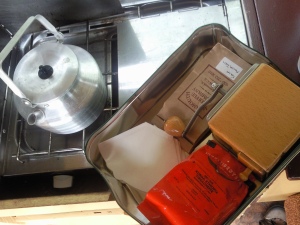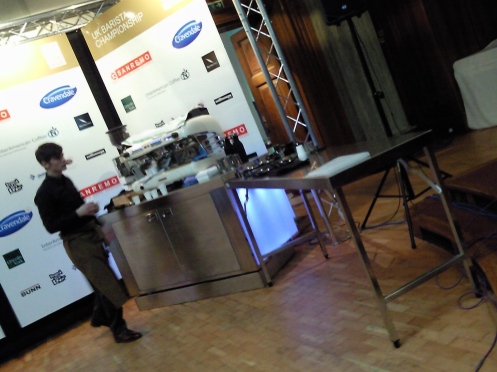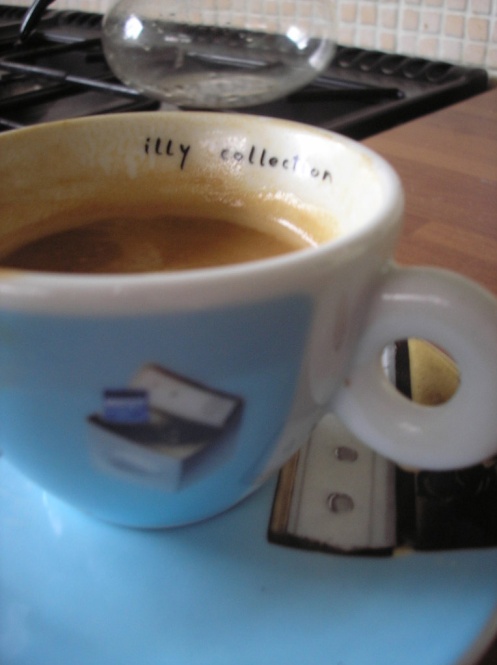Over the winter I’ve been doing up this 1998 Rancilio lever machine. Picked up as a non runner for a ton in east london, I ripped straight into it and got it back on its uppers. I don’t have any before pics as all the covers were off within 30 minutes of getting it out of the van but believe me it was a mess; filthy, corroded and entirely neglected.
With the machine now back on its feet and gleaming like a new penny in the garage, Neil at exchange coffee http://www.exchangecoffee.blogspot.com needed a machine for the gig at Brighton chocolate festival, an ideal shakedown for a newly rebuilt machine.
The machine was faultless for the full 800 drinks we served over the weekend, with just two lever snap-backs caused by my own fuckwittedness and a couple of airlocks in the Flojet requiring a big boiler fill and 10 minutes downtime. Until the evening before the event the machine was only operating on 2 groups because the replacement dip tubes which had to be ordered from Italy had been delayed. They came in the afternoon before the event, result. I hadn’t worried about being a group down as the experience of working the shots at Monmouth in Borough Market had taught me that I am not nearly the fastest shooter in the west and it’s a real stretch to get all 3 groups going on a Linea, but on a lever 3 groups gives you a perfect rhythm for workflow, here goes: Load and lock handle 1, cock the lever to start preinfusion. Get straight on to handle 2, dose, release lever 1 to start extraction, level, tamp, lock and cock the lever. Keep your eye on group 1, dose handle 3, release lever 2, tamp, lock and cock lever 3, by now the shot on group 1 will be just about ready to serve. And repeat…
Temperature management was no real biggie. Those big brass groups are real efficient at sincing (sp?) the excess heat away, a little too efficient for being out in the wind, you need to really work some heat into those groups to get best results. When you’re busy and pulling shot after shot it’s perfect, if you’ve had a quiet spell and not pulled a shot for a couple of minutes you need to get warmed up again. Keeping pucks in the baskets helps, and running through a dead puck before pulling a shot recovers the temp from idle. A bigger problem was an issue with the Robur E which sidelined it only to be substituted by the Mazzer Mini decaf grinder. That was a hot little bastard after a few shots and it was a treat to be reunited with my faithful Major on Sunday, give me one of those over an auto any day.

Pic stolen from here. Permission pending…. http://www.flickr.com/photos/adactio/
Overall I was real happy with the way the machine performed, it’s gonna be a lifer that’s for sure, the shots are beautifully mellow and gooey and working the machine is so much more fun than pushing buttons. There were lots of happy faces around the stall and several returning customers which can’t be bad for a 2 day pitch. We’re doing it all again this weekend (26-28 March) outside the Royal Festival Hall for the London chocolate festival, hope to see you there.






 Having a basic first hand knowledge of roasting coffee is a valuable tool when trying to expand your understanding of coffee in all its forms. You know that roast level is a pretty big factor, but what happens if you arrive at that level in 12 minutes rather than 17? Why did first crack run straight into second? Why did second crack never arrive at all? Sometimes it pays to give yourself questions to answer, drive your research and send you down side tracks to destinations you never expected to arrive at. It also gives you the opportunity to train your palate and refine all of your sensory skills.
Having a basic first hand knowledge of roasting coffee is a valuable tool when trying to expand your understanding of coffee in all its forms. You know that roast level is a pretty big factor, but what happens if you arrive at that level in 12 minutes rather than 17? Why did first crack run straight into second? Why did second crack never arrive at all? Sometimes it pays to give yourself questions to answer, drive your research and send you down side tracks to destinations you never expected to arrive at. It also gives you the opportunity to train your palate and refine all of your sensory skills. And the whole of the South East.
And the whole of the South East. It’s nice up here in the ivory tower; having a choice of some of the highest quality coffee on the planet. Some of them I’m not even that keen on. I will dismiss them as not being hugely exciting or not having developed much from the previous year’s crop.
It’s nice up here in the ivory tower; having a choice of some of the highest quality coffee on the planet. Some of them I’m not even that keen on. I will dismiss them as not being hugely exciting or not having developed much from the previous year’s crop. It’s not just about the gravy. Coffee roasters in the UK may be limited by the availability of interesting clean coffee, but it’s not yet a problem, and it shouldn’t affect their prosperity.
It’s not just about the gravy. Coffee roasters in the UK may be limited by the availability of interesting clean coffee, but it’s not yet a problem, and it shouldn’t affect their prosperity. What cups are you using? Probably not thought about it since you last bought some, maybe you’ve never deliberately bought specific cups for different coffee drinks. Can’t say that I blame you, there are many and greater things to think about, but opening these beauties on christmas morning focused my mind on this very subject and got me through the day.
What cups are you using? Probably not thought about it since you last bought some, maybe you’ve never deliberately bought specific cups for different coffee drinks. Can’t say that I blame you, there are many and greater things to think about, but opening these beauties on christmas morning focused my mind on this very subject and got me through the day. Secondly in this two subject bumper double post is this coffee from the Galapagos Islands. According to the packet it is a blend of washed coffees roasted in September on the island, which is a lot of information compared to commercially available coffee over here. If you have ever drunk coffee destined for its own domestic market you will have an idea of my level of expectation for this coffee.
Secondly in this two subject bumper double post is this coffee from the Galapagos Islands. According to the packet it is a blend of washed coffees roasted in September on the island, which is a lot of information compared to commercially available coffee over here. If you have ever drunk coffee destined for its own domestic market you will have an idea of my level of expectation for this coffee.
 Made myself a shot this morning. Didn’t tamp it, just roughly levelled the dose and banged it in the machine. It was good. Did it again with a naked PF just to check and yep, good again. So pleased was I with the accuracy of my grind setting that I filled up the doser. Made another shot with that same coffee 20 minutes later and guess what? It was good.
Made myself a shot this morning. Didn’t tamp it, just roughly levelled the dose and banged it in the machine. It was good. Did it again with a naked PF just to check and yep, good again. So pleased was I with the accuracy of my grind setting that I filled up the doser. Made another shot with that same coffee 20 minutes later and guess what? It was good.
Recent Comments